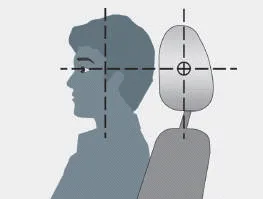Hyundai i30 (PD): Seats / Head restraint
The vehicleŌĆÖs front and rear seats have adjustable head restraints. The head restraints provide comfort for passengers, but more importantly they are designed to help protect passengers from whiplash and other neck and spinal injuries during an accident, especially in a rear impact collision.
WARNING
To reduce the risk of serious injury or death in an accident, take the following precautions when adjusting your head restraints:
- Always properly adjust the head restraints for all passengers BEFORE starting the vehicle.
- NEVER let anyone ride in a seat with the head restraint removed.
 Adjust the
head restraints so
the middle of the head
restraint is at the same height
as the height of the top of the
eyes.
Adjust the
head restraints so
the middle of the head
restraint is at the same height
as the height of the top of the
eyes.- NEVER adjust the head restraint position of the driverŌĆÖs seat when the vehicle is in motion.
- Adjust the head restraint as close to the passengerŌĆÖs head as possible. Do not use a seat cushion that holds the body away from the seatback.
- Make sure the head restraint locks into position after adjusting it.
NOTICE
To prevent damage, NEVER hit or pull on the head restraints.
CAUTION
When there is no occupant in the rear seats, adjust the height of the head restraint to the lowest position. The rear seat head restraint can reduce the visibility of the rear area.
Armrest The armrest is located in the centre of the rear seat. Pull the armrest down from the seatback to use it. Carrying long/narrow cargo Additional cargo space is provided to accommodate long/narrow cargo (skis, poles, etc.
The driverŌĆÖs and front passengerŌĆÖs seats are equipped with adjustable head restraints for the passengers safety and comfort. Adjusting the height up and down To raise the head restraint: 1.
Other information:
Hyundai i30 (PD) 2018-2024 Owner's Manual: Fuses
A vehicleŌĆÖs electrical system is protected from electrical overload damage by fuses. This vehicle has 2 (or 3) fuse panels, one located in the driverŌĆÖs side panel bolster, the other in the engine compartment. If any of your vehicleŌĆÖs lights, accessories, or controls do not work, check the appropriate circuit fuse.
Hyundai i30 (PD) 2018-2024 Owner's Manual: Side repeater lamp replacement
Type A If the light bulb does not operate, we recommend that you have the vehicle checked by a HYUNDAI authorised repairer. Type B 1.Remove the lamp assembly from the vehicle by prying the lens and pulling the assembly out. 2.Disconnect the bulb electrical connector.
Categories
- Manuals Home
- Hyundai i30 Owners Manual
- Engine oil
- Engine compartment
- Safety system of your vehicle
- New on site
- Most important about car
